Sights of Khakassia. The main sights of Khakassia. National Museum-Reserve "Kazanovka"

Khakassia is a real find for an inquisitive and active traveler. There are so many interesting, picturesque, sacred and mysterious places here that a tourist exploration of the territory can continue for many years.
1. Mountain range "Chests"
A mysterious and beautiful place in the vicinity is a ridge of outlier mountains with the colorful name "Chests". Several 200-meter rocky outcrops with picturesque outliers on the peaks on the emerald-green plain are extremely attractive. Once upon a time, these were the vents of ancient volcanoes, lava, having poured out, solidified, forming bizarre rock formations. The attention of tourists and the greatest genuine interest is the ascent to the first "chest", crowned with outliers, with a shaman's chair and rock paintings. In ancient times, such structures were used as cult buildings, they became observatories for observing the stars and the sun, behind such places for centuries a train of mystery, mystery and mysticism stretches.
2. Barrow Salbyksky
The largest among archaeological scientists consider the Bolshoi Salbyksky mound, IV-V centuries BC, Tagar culture. The mound is surrounded by a stone fence made of blocks weighing up to 60 tons, standing vertically. Since in antiquity the burial was repeatedly plundered, scientists are arguing about who was buried here with such pomp, unthinkable for nomadic peoples. The scope of the ancient construction is striking, and it is absolutely unclear with the help of what devices such a megalithic structure could be built. This area of the Kamyzyak steppe is famous for other majestic tombs, but the Salbyk mound is an interesting ancient burial place of the Middle Yenisei.

NS nature arch "Ergaki" an amazing place where, traditionally, due to the variety of natural conditions, a popular tourist center in the south of the republic has developed. It is the most visited region in the Western Sayan Mountains, the pearl of the Siberian land.
The high mountain peaks of the Aradansky, Zerkalny, Dragon's Tooth and Zvezdny natural parks, the Artists' Pass reveal majestic panoramas and pictures of the Ergaki massif. The valley of the Left Taigish, the Lake of Artists, the Lake of Mountain Spirits amaze with unusually beautiful landscapes.
The protected natural territory of the Ergaki park is an excellent laboratory for scientific research, environmental research in order to eliminate negative impacts on natural communities. At the same time, recreational and tourist activities are developing here. Natural monuments on the territory of Ergaki Park are attractive for travelers.

4. Health resort "Lake Shira"
The lake body has unique opportunities for the improvement of people. Mineral healing waters and silt mud help to effectively heal diseases of the gastrointestinal tract, liver, biliary tract. Rest in sanatoriums on the shores of the Shira reservoir is extremely popular today in Siberia.
From ancient times, the Khakass knew about the miraculous lake, its healing power is mentioned in legends. Local residents put yurts on the shore of the lake, lived there for some time and were healed of many ailments. Vacationers began to come here since 1873. Later, the Lake Shira resort received official recognition.
Medical experts note that the mineral-rich lake water, in terms of their ratio, is unique and extremely rare. There are only four bodies of water of this kind in the world. Pearl and mineral baths, therapeutic showers, hydromassage, mud applications and tampons, physiotherapy, swimming pools and saunas will make the therapeutic bathing season pleasant, regardless of the season.
Treatment procedures are successfully combined with an interesting excursion and entertainment program. Most of the visitors to the Shira resort leave here with noticeable relief of symptoms of illness, full of excitement and energy. A significant advantage of the resort is the combined treatment of the Mother and Child vouchers.
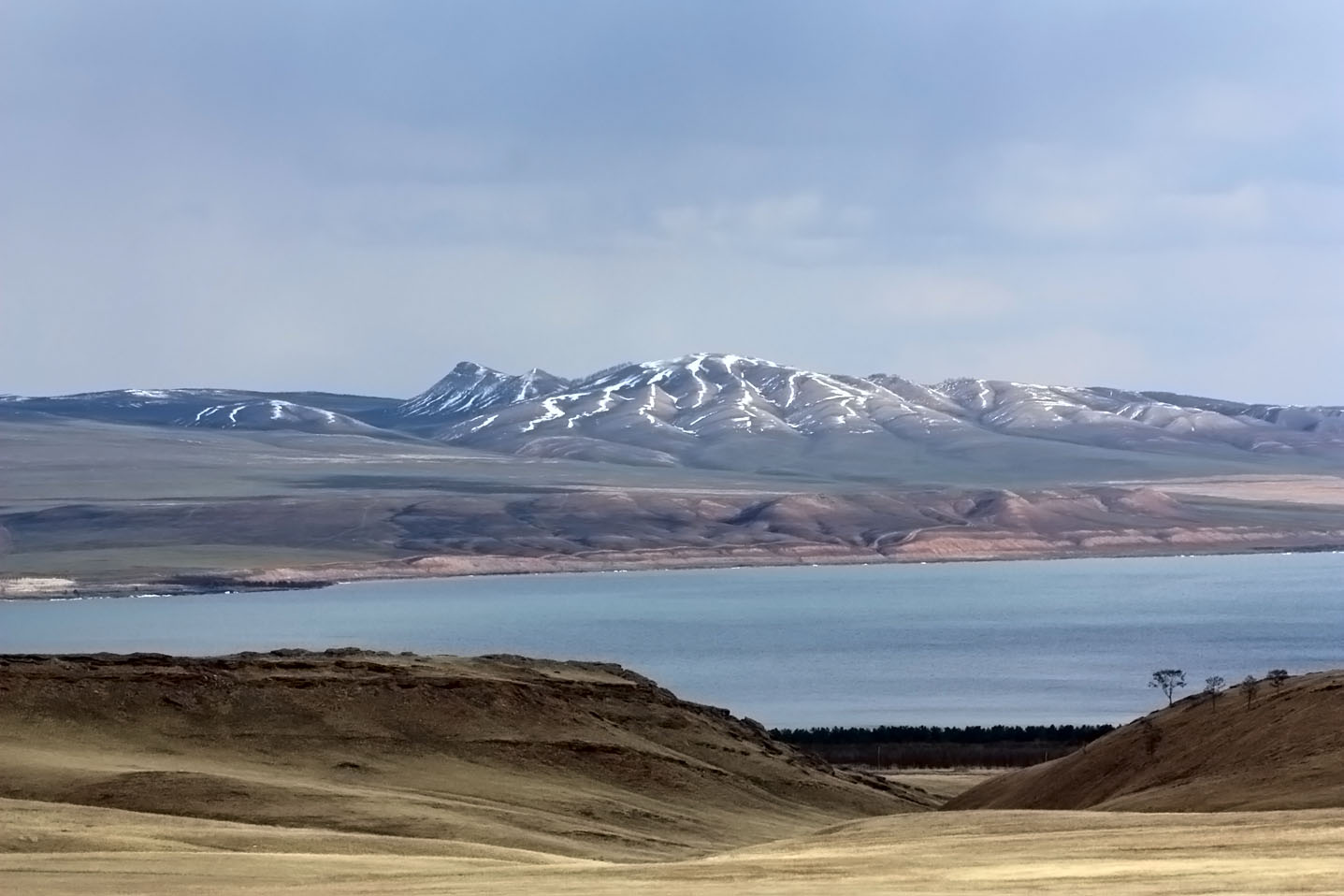
5. Boyar scribble
For specialists archaeologists and travelers in Khakassia, a visit to Boyarskaya Pisanitsa will be very interesting. The oldest petroglyphs will tell a lot about the history of the territory, the peoples who inhabited it at different times. From the expedition of the archaeologist A.V. Adrianova v 1904, who opened the monument ancient culture, the scribble is regularly studied.
The scribble is interesting for scientists because, along with pictures from the life of steppe nomads, log huts of settled peoples are depicted here. The images of the scribble are dated partly to the Tagar culture of the 7th - 3rd centuries. BC e., partly by the Tashtyk culture of the II-I century. BC.
Scenes from the life of the peoples inhabiting the Middle Yenisei at different times open before the travelers. Around the huts and yurts, cattle graze, food is prepared, horsemen hunt, people pray, raising their hands to heaven.

6. Sayano-Shushenskaya HPP
A powerful man-made structure in Khakassia is the Sayano-Shushenskaya HPP dam, reconstructed after a tragic water hammer. The dimensions of the dam, unique in its design, are striking, its length is more than a kilometer, its height is 245 meters, it bound the turbulent Yenisei in a concrete semicircle.
A tourist and recreational region has been formed around the Sayano-Shushensky reservoir. This is the land of the biosphere reserve of the same name with many natural monuments, trout farms and wonderful places for recreation. It is interesting to visit, by contacting the tour desk, the museum of the hydroelectric power station as part of an organized group. From the observation deck opens general form dam, snow-white marble rock Kibik, black taiga on the slopes of the Sayan Mountains and the five-domed sacred peak of the Khakass, Mount Borus.
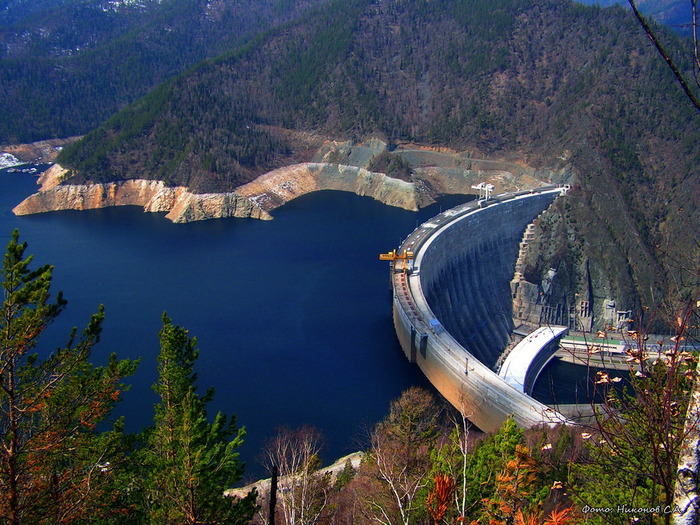
7. National Museum-Reserve "Kazanovka"
The Kazanovka Republican Museum-Reserve of the Khakassians at the foot of the Abakan Range was established in 1996 at the initiative of the authorities. This is 18.4 thousand hectares of land in the Askiz region, where a whole natural and cultural system of unique objects is presented to the guests of the republic.
Here are concentrated unique natural monuments, archaeological settlements, ancient fortresses and irrigation systems, more than a thousand burial mounds located in whole grave fields, stone statues and petroglyphs, memorial structures up to six thousand years old. There are cultural and ethnographic centers here, where you can hear the Khakass speech, learn about the traditions and rituals of the people, try the local cuisine.
The natural landscapes here are surprising, ethnographic features are of genuine interest, archeological monuments are immersed in antiquity with a desire to learn more. For many millennia, people lived here, arranged their lives, honored their ancestors, prayed to the spirits of the mountains, painted on the rocks, erected mounds of striking size.
Every year, experts, ethnographers and scientists, students and schoolchildren, amateurs of archeology and ancient history... Guests and tourists in the museum-reserve are taken along six archaeological routes, they are invited to attend a ritual performance with refreshments.

8. Tuimsky failure
The most interesting place in Khakassia, the so-called Tuimsky dip, similar holes in the earth's crust are formed on the site of old mines. Such a sinkhole occurred in the area of the Tuim village. In 1953, ore deposits were explored here, and a mine for their extraction was opened. The mine eventually deepened into the Copper Mountain, where iron, lead, copper ore, tungsten and gold were mined.
When the main reserves of the deposit ran out, the mine was closed in 1974. The devastated and exhausted lava of the mine inside the mountain did not present any danger at first. But over time, pits began to appear on the mountain, where pets fell. It was decided to blow up the mountain from the inside so that there would be no dangerous voids in it later. As a result of the explosion, a gigantic hole with a diameter of up to 200 meters was formed in the mountain and later expanded. Inside the hole, a 40-meter deep turquoise lake appeared due to copper salts, above which rock walls rise up to 80 meters high.
It is better to admire the Tuim Failure in the summer from a special observation deck. A deep, clean lake at the bottom of the sinkhole, in many adits extending from it, with rails, trolleys, access to a karst underwater cavity, is of great interest to divers.

A fertile land with little snowy winters lay on the way of migrations of peoples during the Great Migration, and many settlers chose Khakassia as their Home and left amazing monuments of ancient culture here. In the steppes and caves of Khakassia, more than 30 thousand monuments of ancient times, most valuable for history, have been preserved - statues on stones and mounds, petroglyphs (drawings and inscriptions on rocks), ruins of mud brick buildings and fortresses, burial grounds and burials, menhirs and statues ... From many archaeological sites are unique and are not found anywhere else in the world. The most famous are the Bolshoi Salbyk Kurgan, Sulekskaya, Boyarsky and Podkunenskaya writings, archaeological monuments of the Chests mountain system, a fortress-sve Oglakhty, Chebaki, medieval burial grounds Kopensky and Uybatsky chaa-tasy.
Khakassia is one of the few regions in Russia where drawings on rocks and statues amaze with their powerful cosmogonic philosophy. Scientists are trying to unravel all the riddles left to us by the ancient peoples in the heritage, according to these monuments of the ancient visual arts... So if you come to Khakassia, you also have the opportunity to penetrate into the sacred world of the ancient Khakass culture!
So, tourism in Khakassia is interesting for its unique unspoiled sunny nature and the originality of this region. In this review, you can read about some of the most interesting places in the archaeological mecca of Siberia! 
Many mounds in Khakassia are thousands of years old. One of the most famous Khak mounds is the Salbyk mound. The construction dates back to the end of the 4th century BC, to the Tagar culture. Initially, the mound towered 25-30 meters above the steppe. Its basis was made up of multi-ton boulders, reaching a height of 6 meters. It is surprising that these blocks for the construction of the mound could be taken only on the banks of the Yenisei, seventy kilometers from the Kurgan, surrounded by bare steppes! At the cost of what effort were these plates dragged, if their weight reached fifty tons, and there were only bulls from transport at that time? And all this gigantic work was aimed at burying one person! Who was this deceased - the King? What was his power? By the monumentality of the building, the Salbyk mound can be equated in some way with the Egyptian pyramids. Unfortunately, the burial mound was excavated by scientists, and today only the boulders themselves, standing in a circle, remain from the Kurgan, but until now, despite the huge number of people who visited it, the Salbyk mound keeps a powerful energy that you will feel on your own. 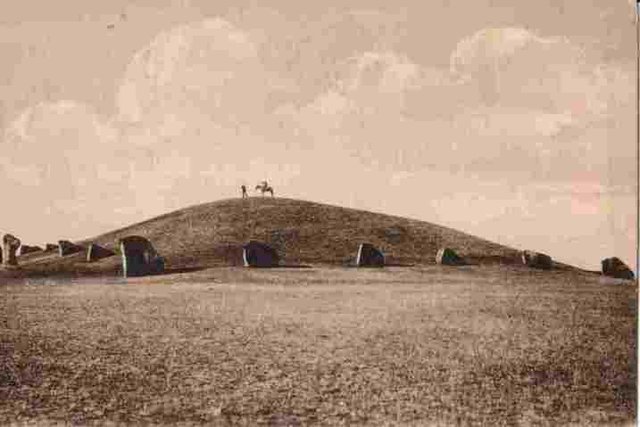
This energy has different charges. Positive energy at the "gates" of the Big Salbyk burial mound. But the northern, rounded slab of highly stratified sandstone has a negative charge. Shamans say that the energy emanating from the earth corrects the human biofield, disturbed by the disease.
Khakass National Museum-Reserve "Kazanovka"
 On the territory of the Askiz district of Khakassia, where the living Khakass language still sounds and Khakass rituals are held, the Khakass republican national museum-reserve "Kazanovka" was created in 1996.
On the territory of the Askiz district of Khakassia, where the living Khakass language still sounds and Khakass rituals are held, the Khakass republican national museum-reserve "Kazanovka" was created in 1996.
The area of the museum-reserve is 18.4 thousand hectares, and here you can find all kinds of cultural and natural heritage of Khakassia: landscapes that have remained untouched for thousands of years and an interesting archaeological fund - petroglyphs, barrows, fortresses, ancient sanatoriums, ecological paths. You can live in Kazanovka for a week and go on a new interesting excursion every day!
Chests
There is a mountain range in the Shirinsky region, the Chests, a unique monument of the Tagar culture. The chests were named so because of the first mountain in the ridge, on top of which there is a rock in the form of a cube, which he calls "the chest of the hero Khokho-Babai". According to popular beliefs, it contains all the treasures of the valley. Chests is the oldest astrological observatory, more than 13-14 thousand years old! In the ancient Khakask language this place is called "Onlo", which means "to see", "to observe". From here, the ancient astrologers watched the sun and moon sunsets and rises. 
In Onlo there is a unique, the only such monument on Earth - the Temple of Time. If you climb the Temple of Time, then you understand why it was needed. In front of the mountain on which the Temple is built, there is a stonework. You stand on it facing the Temple, look to the right, and you will see the protruding top of the fourth "chest". This is the exact astronomical direction to the north. From this point, the priests determined the day winter solstice... Through the gap between the stone, similar to an eagle's head, and the mountain, the Sun sends the last ray to the Earth and sets below the horizon. 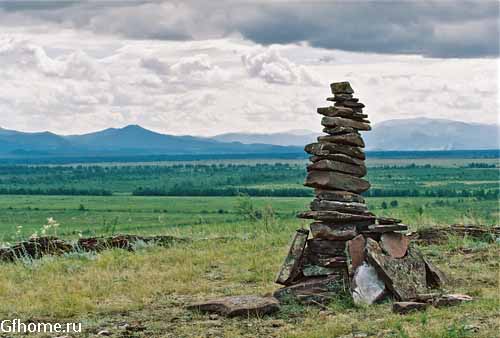
In the Temple of Time there is an image of a dragon divided into six equal parts. This is a solar, year-round clock - one of the first on earth! From sunrise to noon, the shadow from the wall slides from left to right, going one division in about an hour. At noon, the temple of time is fully illuminated, and in the afternoon, the shadow from the wall slides in the opposite direction, passing one division in just a few minutes.
The Republic of Khakassia is located in the south of Western Siberia in the left-bank part of the Yenisei River basin, in the Sayano-Altai Uplands and the Khakass-Minusinsk Basin. In the west, the Republic of Khakassia borders on the Kemerovo Region, in the south with the republics of Altai and Tyva, and in the east with the Krasnoyarsk Territory. Khakassia is stretched from north to south for 450 km, from west to east - up to 250 km. The area of the republic is 61.9 thousand sq. Km. The population is 538,054 people (according to the 2009 census), the population density is 8.7 people / sq. Km., The share of the urban population is 71.1%.
By the nature of the relief, the mountain (eastern slopes of the Kuznetsk Alatau and Abakan ridge) are distinguished, the northern slopes of the Western Sayan - up to 2930 m high) and the flat (Minusinsk, Chulym-Yenisei hollows) parts. Plain areas are located along river valleys and are called steppes (Abakanskaya, Koibalskaya). The main rivers are Yenisei and Abakan. There are numerous lakes with fresh (Black, Fyrkal, Itkul) and salty (Bele, Shira) water. The climate is sharply continental. Winters are cold and with little snow (in the depressions), the average January temperature is -18 ° С. Summer in the basins is hot (the average July temperature is +18 ° C), in the foothills and mountains it is cooler. Precipitation ranges from 300 mm per year in depressions to 700 mm in the mountains. Mountain taiga forests cover the entire west and south of Khakassia, the area covered with forests is 3.3 million hectares. In the steppe and foothill regions of Khakassia, there are mole, ermine, Siberian weasel, in the mountains - squirrel, white hare, wolf, fox, bear, from birds - hazel grouse, capercaillie, in rivers - taimen, tench, burbot.
The Republic of Khakassia is located in Southern Siberia in the left-bank part of the Yenisei basin, on the territories of the Sayano-Altai Upland and the Khakass-Minusinsk Basin. Large rivers - Yenisei, Abakan, Tom, Bely Iyus, Chorny Ius, Chulym (the last four belong to the Ob basin). On the Yenisei - Sayano-Shushenskaya HPP and Mainskaya HPP.
The date of the official consolidation of Khakassia for The Russian Empire can be considered August 20, 1727, when a border treaty was concluded between Russia and China. All the lands on the northern side of the Sayan Mountains went to Russia, on the southern side to the Chinese Empire. The actual consolidation of the territory of Khakassia happened later. In 1758, Chinese troops invaded Altai and defeated Dzungaria. There was a threat of violation of the officially recognized borders of the Russian Empire. The tsarist government hastily placed Cossack garrisons on this plot of them. Since the time when the Cossacks began to carry the border service, Khakassia was actually consolidated in the Russian Empire.
At the end of the 19th century, the Khakases were divided into five ethnic groups: Sagays, Kachins, Kyzyls, Koibals and Beltyrs. Russia has given a strong impetus to accelerate socio-economic and cultural development. The creation of industry, the development of natural resources, the creation of a system of health care and education began.
70 kilometers from Abakan, if you go in the direction of Sorsk, there is the Salbyk Valley, it is also the Valley of the Kings and the Valley of the Spirits. Tsars are the leaders of the Tagar tribes, solemnly buried here in time immemorial. Today, an open-air museum "Ancient burial mounds of the Salbyk steppe" is organized in the valley. Archaeologists dug up and investigated the Big Salbyk Kurgan in the middle of the 20th century, and then discovered that it had been plundered back in the Middle Ages. The valley is a protected area, but also a place for conducting ceremonies (which is confirmed by an official plate). Five kilometers from the Bolshoi Kurgan are the so-called "Shaman Gate" - two menhirs, male and female. Both are considered sacred and it is not recommended for mere mortals to pass between them. This can only be done by a shaman during the ceremony. The Sunduki mountain range, which stretches for two kilometers in the Shirinsky and Ordzhonikidze districts of Khakassia, occupies a special place in the lists of Russian "places of power". The chests are called the Siberian Stonehenge, although the five rocks - "chests" of an unusual shape are not man-made, but natural works.
There are no less petroglyphs in Khakassia than in Karelia. The most significant monuments are the Sulek writings in the north of the republic, associated with shamanic cults, and the Boyarskaya writings with various everyday scenes in the Bogradsky district. Rock carvings can also be seen in the Kazanovka nature reserve in the Askizsky region. This is perhaps the most interesting place for those who are interested in authentic folk culture. Kazanovka is an open-air museum that preserves the historical landscape and the historical way of life. On the territory of Kazanovka there are six villages, two thousand archaeological monuments, four "paths of spirits", a recreated aal (traditional village) with all typical buildings, a healing stone Akh-Tas, a sacred rock Iney-Tas - in general, a trip through the reserve will be a complete immersion to the Khakass world.
Posted Sun, 29/05/2016 - 10:25 by Cap
Khakassia is an interesting and mysterious land located in the Western Sayan Mountains, slightly east of Altai. The joint of Altai and Sayan mountains makes this place mysterious and attractive!
Remnants of ancient beliefs, practiced shamanism, pathogenic places, mysterious caves in the deep taiga, habitats of spirits - all this and much more is found in Khakassia.
As for the anomalous zones, there are three of them in Khakassia. There is also a Valley of Death, in which the space-time continuum is curved (a time bag) Let's just say not the most pleasant place. Located in the north of Khakassia. The second place is located 33 kilometers upstream of the Abakan River from our city of Abakan. Quite often, people who spent the night in that valley went crazy or died under strange circumstances.
The third is located in the area of Lake Fyrkal in the direction of Kommunar to the north, but you cannot get there by car, only on foot. A lost place, even the beast bypasses it. Ufologists say that it is part of one of the twelve anomalous triangles on the planet, such as the Bermuda Triangle.
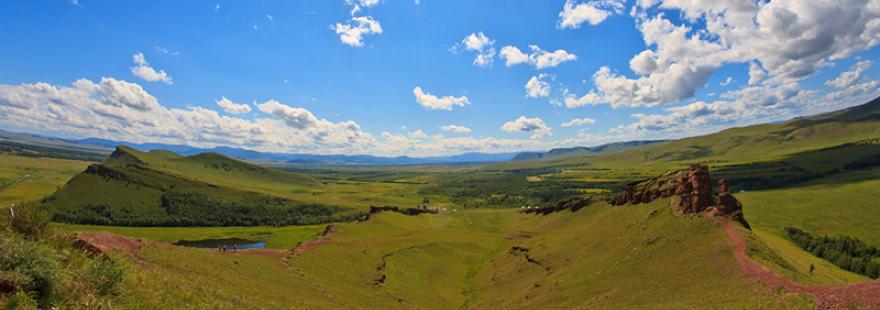
"Chests" in Khakassia
Imagine a valley with a diameter of 12-15 km, surrounded by mountains. In fact, in the center of this valley there are stone pyramids - among the people they are called "Chests" for the unusually regular shape of the peaks in the form of squares.
The length of these pyramids is about 300 m, the height is 60-70 m. They are, in general, a complete copy of the pyramids of the Aztecs and Mayans. When I first saw them, I was just confused,
I couldn't believe my eyes. By profession, I am a historian, an archeologist, and to see this at my side is something unimaginable. There are three villages next to these pyramids.
At first, naturally, I began to ask local residents about these structures. Fortunately, one of my classmates lived in such a village, and through him I managed to get to know many. Everyone was unanimous - the place is dark, there are constantly "flying" spirits, in no case there is no need to meddle. My desire to spend the night on the top of the most preserved pyramid of all (and there are about 12 of them), a reaction like a plague patient. They curl their fingers at their temples and try to get away as quickly as possible.
Finally, with two comrades, I stayed on the Chest. The night passed relatively calmly, except for all mystical things, such as - exactly at twelve o'clock the constantly blowing wind ended and an extraordinary silence came. One could hear the bells of the cows sounding in a distant village, about ten kilometers away. Then an unexpectedly small hollow was filled with a thick fog. And then, in the complete absence of any movement of the wind, I suddenly heard the rustle of branches and the rustle of foliage (larch was growing in the hollow). This, excuse me, could not be. However, we digress from the topic.
So that's it. The wind blew out again exactly at 3 o'clock in the morning. (Later I checked, sleeping several times, all the miracles exactly according to the schedule!). After a few hours, the sun began to come out, and since it was a full moon, I looked to the west, the moon was setting there - but what happened to it! The dark red disk began to rotate unlikely around its axis, change its shape, more and more striving towards the ellipse. Moreover, all these metamorphoses took place in a matter of minutes, not just seconds! Until the sun rose almost completely, my friend and I (the second slept in a tent), stared at the bloody disc, unable to tear ourselves away.
A lot of time has passed (it was 1991), but to this day, although not so clearly, I remember this disc of the Moon, morphing by its whim. He did not promise anything good.
When we came to the village and had a good sleep, I began to ask the locals, and found out that all kinds of UFOs of all sizes, from balls and to plates, and all kinds of colors, and are looking for the valley of "Chests". When their accuracy was especially high, no one knew, they just celebrated the days of their appearance. By the way, I was told that near one of the "Chests", back in Soviet times, a stone was dug (they plowed the field and opened the shaman's grave with a tractor), which depicted constellations of the other hemisphere, and some stars visible almost through a telescope ...
Honestly, I was not able to verify this information, some say that everything they found was taken to some St. Petersburg institute, others do not really remember anything at all, so I can’t confirm, much less disprove it. But! For more than 20 years, the world-famous scientist, professor, writer, archeologist Vitaly Epifanovich Larychev has been going to this valley to dig. He even has a book on Chests. I was very interested in this strange connection between "Chests" and UFO. In general, there are many legends and stories about this valley. It is reliably known that a powerful people lived in it for a long time, for they built stone houses, fortresses, skillfully used natural structures. And when the Mongols in the 12th century passed here - they cut out the entire population and tried to destroy all the incidents! There was no such thing behind them. To everything and everyone !!! Now NOBODY knows what was there, and who lived there !!!
For example, I strongly suspect that there was not a simple people there, professing their own not shamanistic religion at all. There is a suspicion that there are hollow places in the piled-up tops of the chests, and there something is waiting for its time. By the way, I forgot to say. If scientists cannot name the exact date of how long ago people lived in the valley, what they call the time of existence of the pyramids - 35-40,000 years ago they arose, and since then they have remained almost unchanged!
It is located in Kuznetsk Alatau (Khakassia), four kilometers from the village of Malaya Syya, on the left bank of the White Ius River. The length of the passages of the cave is about 11,000 meters and the depth is 195 meters.
The cave was discovered in the 1970s. The name of the cave was proposed by a Novosibirsk biologist and was chosen by lot from a number of other names.
The cave contains numerous wells, large halls, galleries on several levels, cave lakes, and dripstone formations.
One of the most dangerous caves in Russia.
There have been three fatal accidents in the Pandora's Box cave since its opening to the present.
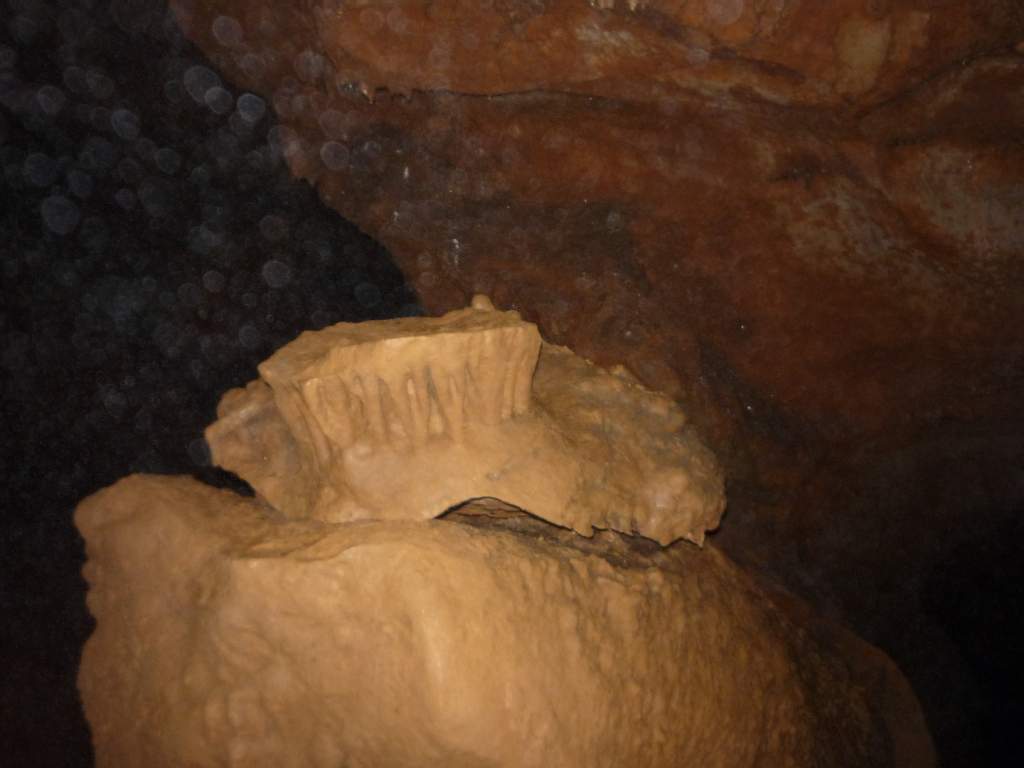
PANDORA'S BOX. GENERAL INFORMATION.
Pandora's Box is a cave on the left bank of the White Ius River, in Kuznetsk Alatau, Republic (Khakassia).
The length of the mapped passages of the cave is about 11 km, the depth is more than 180 m. At the present time, on the initiative of the Krasnoyarsk cavers, work is underway on a new topographic survey of the cave, including previously undiscovered passages. A labyrinth-type cave, in limestone, has one entrance.
There are numerous wells, large halls, galleries on several levels, cave lakes, drip formations. The average temperature is +5 ° С.
There are bats.
The cave was discovered in the early 1970s by the staff of the Syiskiy Glaciological Station. At that time, the cave was the only entrance light grotto Shirokiy. Since 1976, speleologists Osinnikov, led by V. Vlasenko, have attempted to penetrate the underground system through neighboring shallow caves.
In 1981, purposeful excavations at Shirokoye by speleologists in Osinnikov and Tomsk uncovered a passage to the upper floors of the cave. Later, speleologists from Novokuznetsk were also engaged in the study of the cave. The name of the cave was suggested by the Novosibirsk biologist N.P. Mironycheva-Tokareva, and was chosen by lot from a number of other options.
Cave incidents
Three people died in Pandora's Box.
12/03/1989 Andrei Ageev from Novosibirsk crashed to death.
In the summer of 2003, the Novosibirsk archaeologist Stanislav Shubin died in the upper part of the cave.
02/02/2005 while trying to dig a course in continuation at the bottom of the cave, the Novosibirsk speleologist Pavel Galkin died under the rubble.
There are also reports of tourists missing in the cave.
Anomalous phenomena took place in the cave.
Pandora's Box, Emerald Lake 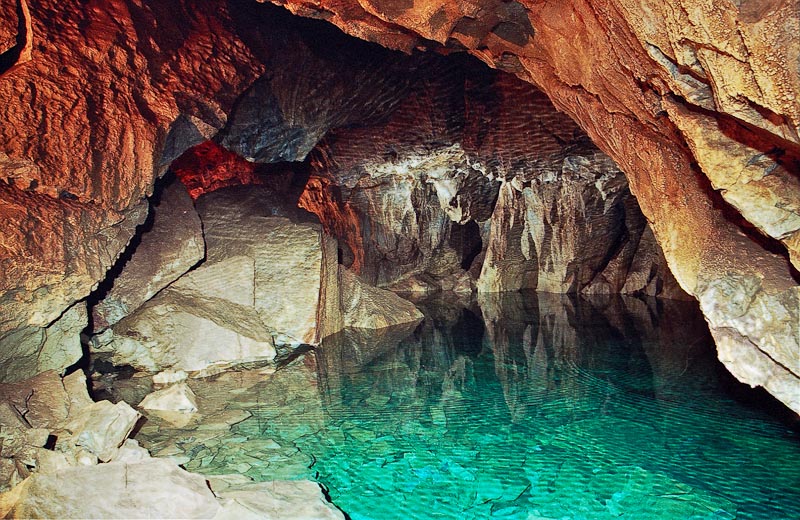
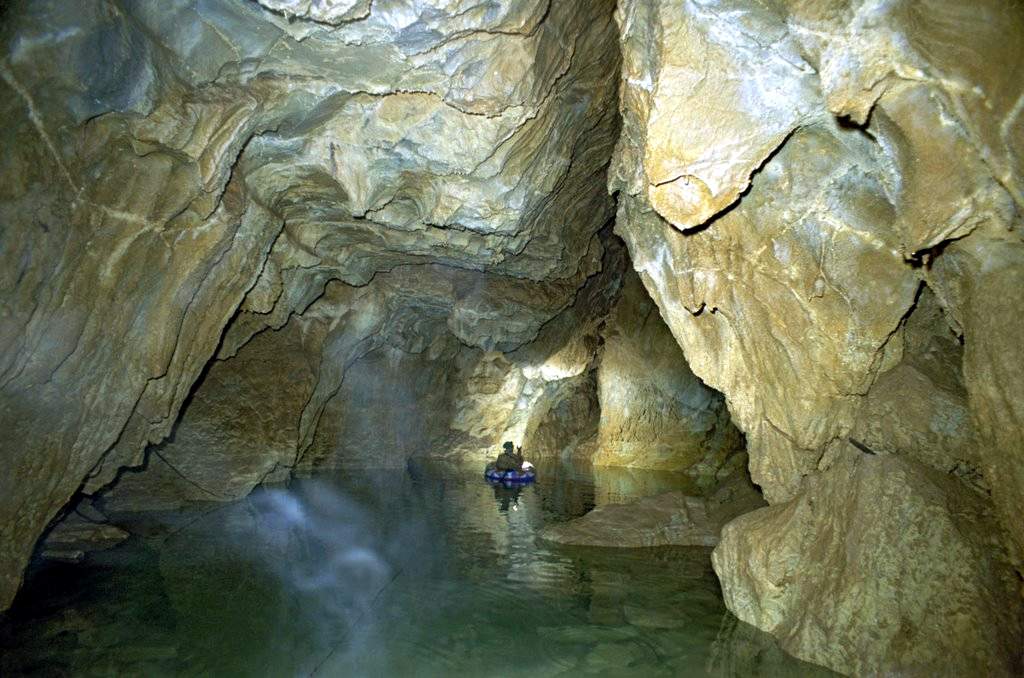
Hurtuyakh-Tas statue
Khurtuyakh-Tas is translated as "Stone Old Woman". People believe that she helps and fulfills desires. Childless women go to her to beg for children, men ask for the fertility of the land and cattle. They bring her gifts and leave her at the foot. It is located in the steppe of the Askiz region.
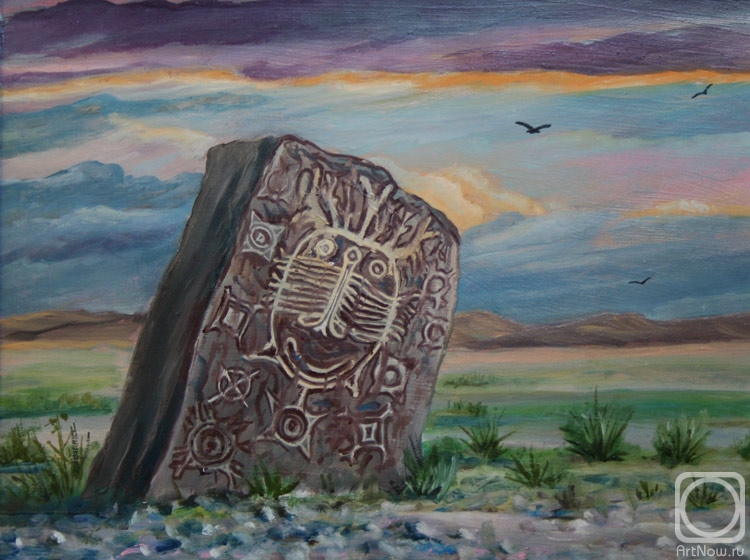
Seismic zone
Abnormal zones with increased energy are common. Old burial mounds with lying stone slabs are popular with residents. You stand on the stove, raise your hands up - and you are in a stream of power. Yesterday 10.02 in 170 km to the south of Abakan in the Tashtyp region there was another earthquake of 6 points. Even 20 years ago, there was no such thing in these places. Maybe seismic activity started in response to our visits?
"Askiz poltergeist",
involuntary miracles in Askiz, which killed three people. A book has been written on research material, which is being printed now, to the amount of 5000 copies. in the publishing house "Science". There is a huge video footage - three cassettes, three hours each. Filming of the place, memories and stories of eyewitnesses, special filming using scientifically developed methods.
Research "Mercury Man".
Krasnoyarets Zhigachev / I don’t remember his name /, visited the flying tray. After that, mercury began to be synthesized in his body! At first it was just bumps on his legs, the doctors prescribed heating for him, the bumps enlarged, he was cut open and the doctor was horrified, mercury poured from the cuts! He was urgently sent to Krasnoyarsk. I will not repeat much. I am under the impression of video footage / also about nine hours of video / - professors and academicians in the hospital open up his tumors - and mercury is pouring from them on the operating table! SUCH I CANNOT IMPROVE EVEN! Academics and professors raise their hands in front of the camera. Its organism is really synthesized with mercury! Clots of mercury were found in the muscles, skin of the legs, in the scrotum, and in the lungs. During a special scan in the clinic, mercury was found in the bones of the legs !!! All This is filmed !!! EVERYTHING is seriously documented !!!

Suicide zone
Last week in Khakassia, five people committed suicide over the course of two days. In this regard, one Indian film comes to mind. The plot is as follows. The guy and the girl love each other, but the girl's evil father does not allow them to get married, and the young, instead of sending him to hell, decide to jump into the abyss together. When the girl falls, she breaks to death, and the guy clings with his shirt to some snag, from which he cannot unhook himself, and thus remains alive.
In Russia, for a failed suicide, you can get off with a week of mental hospital, but in India (as well as in some other countries) it is quite possible to get a real term for this. In general, the guy gets a year in prison. When he leaves, he finds another girl, marries her. But the evil dad of his first lover arranges a car accident for the newlyweds, as a result of which both die.
Several years ago, one of the Abakan psychiatrists told me in an interview that in some areas of Khakassia there is some kind of anomalous "suicidal" zone. It was then about the Tashtyp region. This area, for some inexplicable reason, had the highest suicide rate in the region. Today, such zones may have "moved" to other territories.
Just like a couple of years ago, so today, people who decide to commit suicide are mostly hanged and shot. They shoot more often from hunting weapons. The free turnover of combat, as you know, has been prohibited in our country since the time of Lenin (although in the former socialist camp of Eastern Europe, as well as in the Baltic states, this ban has long been lifted). This is probably correct. We are not the kind of people to buy military weapons and lock them with seven locks. In the hands of our person, it will certainly shoot, and if not in others, then at himself. Anyone on our streets will say that in Russia the number of murders and suicides will only increase from the lifting of the ban on the free possession of military weapons. And this does not play into our power at all. Was it in vain that, for the sake of improving the demographic situation, we invented the so-called "maternity capital"?

Stone old woman INEY-TAS
Location: the picturesque rock Iney-tas (Stone old woman) is located a kilometer northeast of the village of Kazanovka, in the Askiz district of the Republic of Khakassia, on the left bank of the Askiz river
Iney-tas has been patronizing cattle breeding since ancient times and “helped” people up to the 50s of the last century. At Iney-tas, tag taig was performed - rituals of sacrifice to the mountain spirit, the patron of the clan, and asked for help in various matters. At the very foot of Iney-tas, an area was cleared and sprinkled with river sand, on which 14 sculptures of domestic animals were installed. Bulls, horses, sheep were made from river pebbles and red sandstone. Only three figurines have survived from this collection. And the Frost Tas itself was blown up at the very beginning of the 60s of the last century.
During the war and in post-war years people began to come to Hoarfrost tas again and conduct rituals here. The then ideologists did not think of anything better than to destroy the cult monument. The amazing open-air temple was destroyed. They say that after that, the cattle in Khakassia began to reproduce worse. They also say that none of the participants in this sacrilege ended their lives safely. And Iney-tas even after "death" enjoys special reverence.
Now the mountain where the stone stood is called Hoarfrost-paary (the foot of the Hoarfrost). Here again rituals are held, passing by all means "sec-sec", on the branches of birches, the grove of which surrounded the place where the Stone Old Woman used to stand, a turban is tied. Those who have been here can fully experience the beauty and power of this unusual place, where grandmother Frost, even having lost her former appearance, again helps her people.
How to get there: from Abakan to the village of Askiz (92 km.). Further to the village Kazanovka about 30 km
Geographic coordinates: 53.22589 90.071927
Address:
Askiz district, with. Casanovka
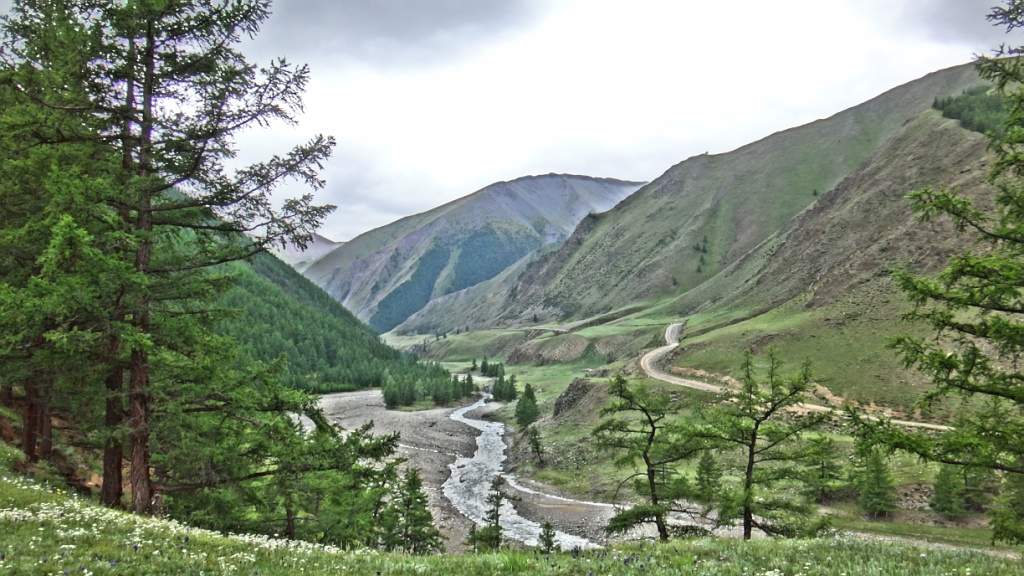
Mainsail DOUBLE EYE
Grotto Two-Eyes
Location: the grotto is located 50 km west of Abakan in the Bogradsky district of the Republic of Khakassia, on the river. Hustle 1.5 km west of the village of the same name
Two-eye (Grotto "Two-eye", "Looks") is a multi-layered natural monument of the Stone Age in Khakassia. This name is due to the fact that in its vaulted ceiling there are two light holes of natural origin - two "eyes".
This is the earliest known site of ancient people in the Minusinsk Basin (100 - 35 thousand years ago), explored by Z.A. Abramova in the 1970s. The entrance to the grotto is located at an altitude of about 50 m from the water's edge. The grotto is very comfortable to inhabit. It is spacious (15 m deep and 7-10 m wide), is oriented with its entrance to the south and is well warmed by the sun.
During the excavations, several cultural layers were revealed, the lower of which belong to the Mousterian era. This is the time of the Ries-Wurm interglacial (100 - 80 thousand years ago) and the Wurm glaciation (80 - 12 thousand years ago). Geologists believe that the climate was relatively warm and dry back then. Steppe vegetation predominated near the grotto. In the valley of the Yenisei, dark coniferous forests grew: spruce, cedar. There was a lot of birch. Stone tools and many animal bones (food waste) were found in the grotto; the bones belonged to a wild ass, horse, rhino, bison, argali, saiga, and reindeer. Of the predators - the bones of a hyena, lion, bear, wolf, fox. From 40 thousand years ago, the layers belonged to the Late Paleolithic, and from 12 thousand years ago (upper 2 layers, 50 cm) to the Mesolithic.
How to get there: along the M-54 highway from Abakan to the village of Krasny Kamen (about 47.5 km). Further to the village of Borodino 10 km. The grotto "Dvuglazka" is located 2.5 km from the village of Borodino and 1.5 km from the village of Tolcheya
Geographic coordinates: 54.084856 91.064752
Address:
Bogradsky district, village Tolcheya
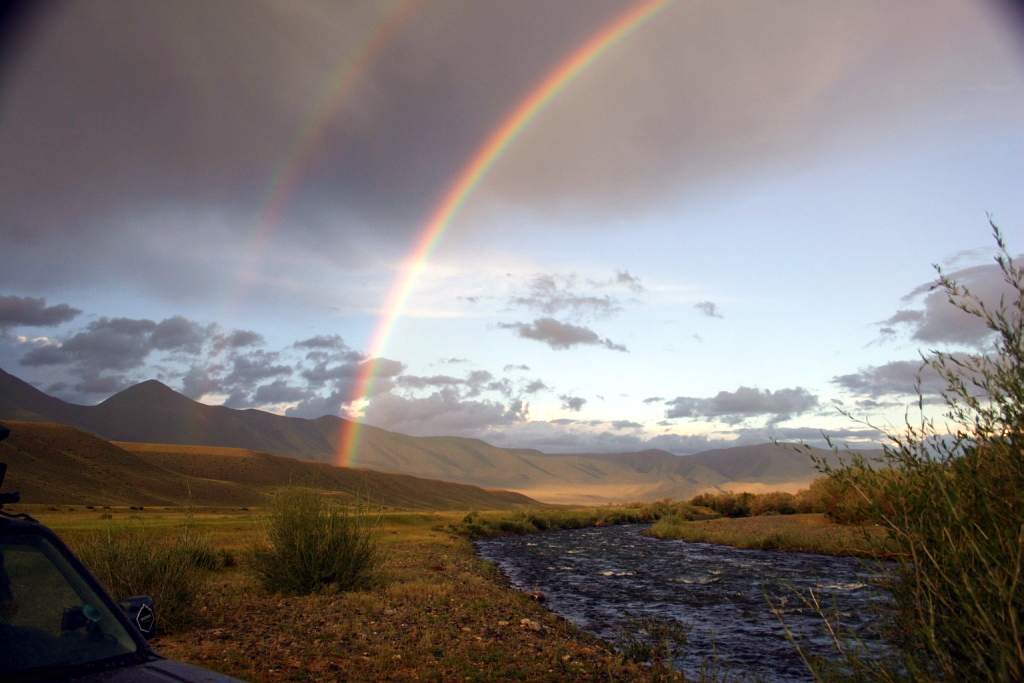
Mount CHALPAN
Location: the mountain is located on the territory of the State Nature Reserve "Khakassky", on the site "Lake Bele" in the Shirinsky region of the Republic of Khakassia.
The height of the mountain is 586.3 above sea level. Mount Chalpan is a mountain rise on the northwestern shore of Lake Belyo. On the southern steep slope, there are stony steppes with outcrops of rocks, on gentle slopes, various variants of steppe phytocenoses. A birch-larch forest stretches along the coastal strip. On the southern slope of Mount Chalpan, there is a unique scribble, which is a graphic chronicle of history. Archaeologists have established that some of the rock carvings of Mount Chalpan date back to the second millennium BC.
Mount Chalpan has environmental, scientific, aesthetic, educational, aesthetic and recreational significance. Here in the old days the Khakass mined donkeys for the point of knives. An ancient fortress is located on the top of Chalpan Mountain.
How to get there: from Abakan along the M-54 highway to the village of Znamenka 80 km, then turn left and go 55 km to the village of Borets. Further about 32 km to the village of Shira. Lake Bele is located about 25 km from Shira.
Geographic coordinates: 54.703889 90.154167
Address:
Shirinsky district, Lake Bele
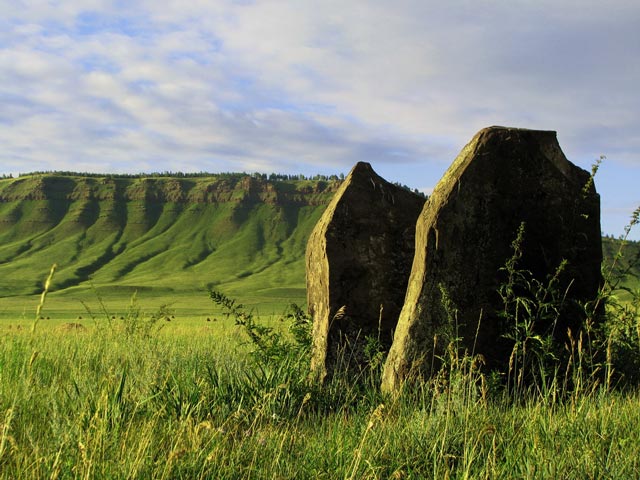
Ancient Temple Complex ZENKHIR
Location: The ancient temple complex Zenkhyr (Uzynkhyr) is located in the Ust-Abakan region of Khakassia, near the village of Prigorsk
Translated from Khakass, Uzynkhyr means "long ridge". The city with all its buildings has practically sunk into the ground. Only the thick, not less than 2.5-3 m, stone walls of the temple are clearly visible, which is 15-20 m distant from the settlement proper. The material for the construction, obviously, was delivered from the ancient quarries and the rocky bank of the Yenisei. According to scientists, Zenkhyr was built by the Afanasyevites. Until now, it was believed that they did not build cities, but lived in small villages and settlements scattered along the banks of rivers. However, Zenkhyr refutes this point of view.
How to get there: from Abakan to Prigorsk about 30 km. The Zenkhyr temple complex is located about 3 km from the village of Prigorsk
Geographic coordinates: 53.931111 91.286389
Address:
Ust - Abakan region, Prigorsk settlement
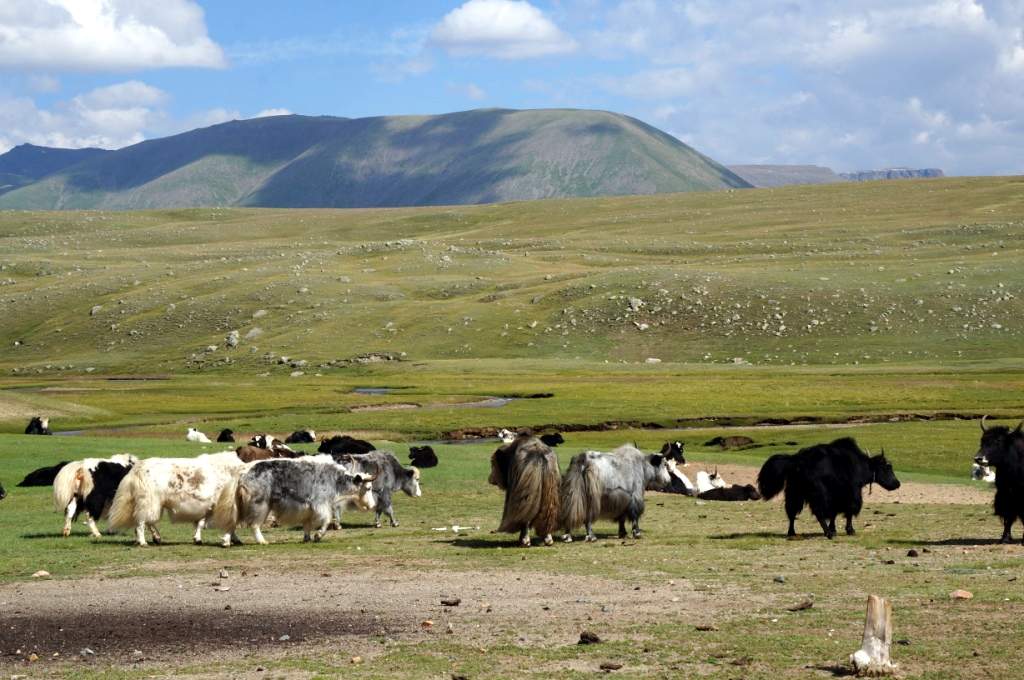
Mount KYUN TAG (KUNYA)
Mount Kunya
Location: the left bank of the Krasnoyarsk reservoir, not far from the village of Ust-Abakan, Ust-Abakan district of Khakassia
The ancient mountain Kyun Tag or Kunya, translated from Khakass means "Mountain of the Sun" and is a cult and sacred mountain for the Khakass, for worshiping the Sun deity. The height of the mountain is over 400 meters. At the top of Mount Kunya there is an ancient fortress, from where a stunning view of the Yenisei valley opens.
Back in the Bronze Age, more than 4000 years ago, people used this mountain in order to hide from enemy raids. It stretched along the ridge separating the gentle slopes of the mountain from its interior, where not only women and children, but also livestock could take refuge in the decays. And male warriors could successfully defend the wall from enemies. It was unrealistic for the enemy to get inside the fortress along the steep slopes - even weak women and children could easily throw the attackers down, dropping fragments of limestone on their heads. There is a lot of limestone in these places, which made it possible to fold the wall without much labor. The ancient fortress has been used for thousands of years.
Mount Kunya is a grandiose monument of rock art. A small, only a few tens of meters in length, a section of the wall cuts off a cape with a flat ritual platform. The famous Podkuninskaya Pisanitsa is located on the rocky cliffs of this cape. The ancient drawings of the scribble depict 323 figures: people, deer, goats, horses, camels, birds, bears. The drawings are dated back to the 2nd millennium BC.
How to get there: from Abakan to Prigorsk about 30 km. Further 12 km to the village of Mokhova. Mount Kunya is located 3 km along a dirt road from the village of Mokhova
Geographic coordinates: 53.889803 91.418744
Address:
Ust-Abakansky district, town. Ust - Abakan, aal Mokhov
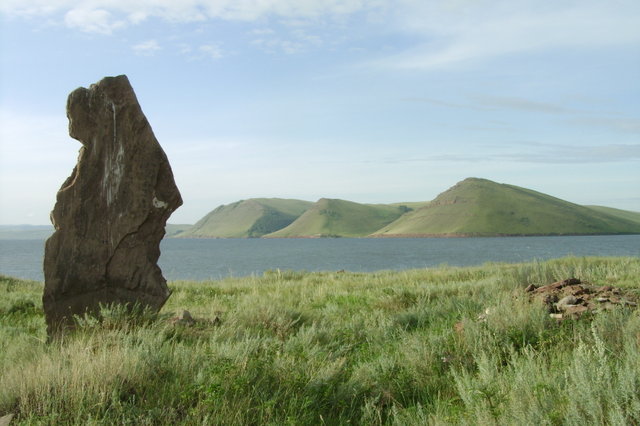
Tuim ring
Tuim ring
Location: the ancient monument is located at 8 km of the road from Shira village to Tuim village, in the Shrinsky district of the Republic of Khakassia
Tuim-ring is a funeral and cult monument of Okunev culture. It is one of the most interesting objects in Khakassia. A large square is laid out on a flat area between the road and a rock of stones, the diagonals of the square are also lined with stones. A cromlech (a circle of dug-in menhir stones) with a diameter of more than 80 m was built around the square.
In the center of the monument are the slab graves of a woman priestess and two children. There are 4 large stones around the circle, marking the four cardinal points. From the female burial to the east, a symbolic path is laid out, bordered by several small stones. In its way, the monument is unique and is comparable in value to the English Stonehenge, although it is inferior in size.
There is an opinion that the Tuim-ring was not only a cult place, but was also used as an ancient observatory - the stones at the corners of the Tuim-ring are oriented to the cardinal points.
Unfortunately, during the construction of the road, the old cromlech was destroyed, and now you can see only its modern restored version. But the spirit and energy of the old place remained.
How to get there: from Abakan along the M-54 highway to the village of Znamenka 80 km, then turn left and go 55 km to the village of Borets. Further about 32 km to the village of Shira. The distance from the village of Shira to the village of Tuim is 18 km. The ancient monument "Tuim ring" is located on 8 km of the road from Shira village to Tuim village
Geographic coordinates: 54.393869 89.948518
Address:
Shirinsky district
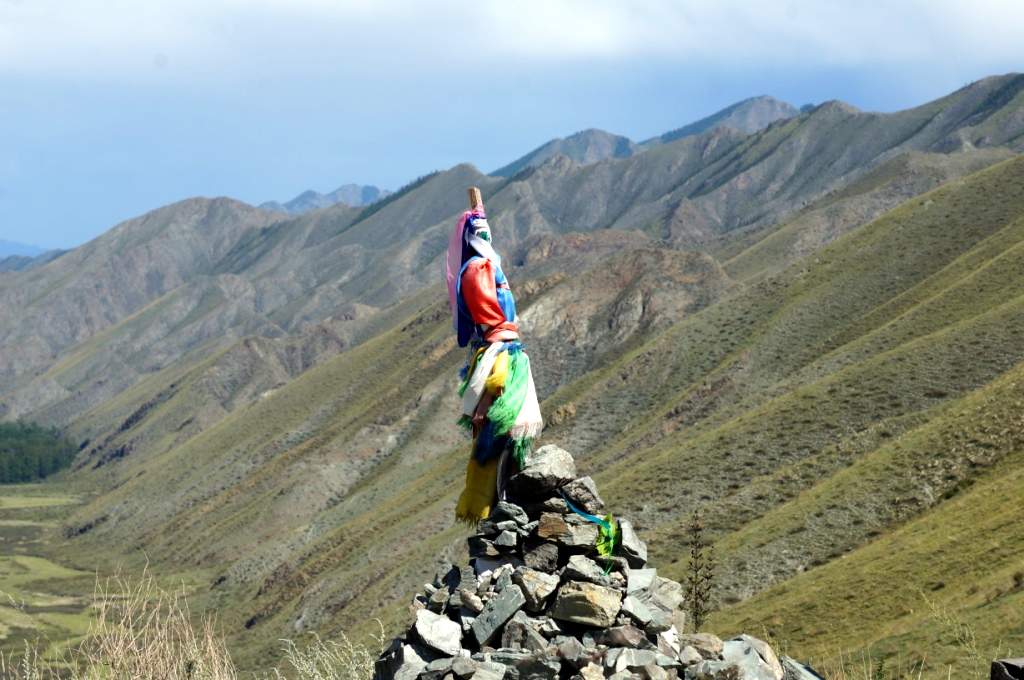
Gravity anomaly
The Abakan-Sorsk road, not far from the turn to Lake Ulukh-gol, in a place called Kuten-Buluk - a gravitational anomaly - cars themselves go uphill, and the water runs uphill.
Possibly large ore deposits.
Julia mine
Bogradsky District Mine Julia. True, it is impossible to call it a uranium mine. since uranium was not specifically mined there, but there are uranium deposits ...
but for 30-40 years it has not worked and the village has been abandoned. UFOs have been observed.
Abnormal zones in the taiga
In the taiga regions of Khakassia, small areas of terrain with ugly trees are often observed, lightning often strikes these places, sometimes ball lightning is observed. Mechanical clocks in such places are in a hurry or lagging behind, by 2-3 minutes per day. When being in such a place, a person feels some kind of insecurity, fear. The zone is usually well delineated, outside of the zone everything is fine. Such zones are well identified by biolocation, the frame deflection angle reaches 180 degrees.
MYSTERIOUS FOREST
Nature is fragrant with luscious green herbs and the scent of flowers, the quiet whisper of leaves under a gentle breeze and the singing of birds creates a unique peace and comfort in the soul. In the shade under the cool crown of a spreading spruce, it is good to rest lying on the grass, where life is also boiling, hard workers ants scurry about, a beetle is crawling busily somewhere, a grasshopper chirps somewhere, but a chipmunk with swollen cheeks or a squirrel slipped through the branches of a pine tree - such an understandable and the usual life of the taiga.
Slowly I climb the slope to the hill and suddenly before my eyes an unusual picture violating the harmony of the taiga: not far off there is a large dark spot of a dead forest, the green grass suddenly breaks off, under my feet there is a thin layer of gray dry moss, the mighty trunks of ugly trees are completely naked, without bark, branches of a bizarre shape, now they are almost twisted into a spiral, now they are spread out in some completely unnatural way and not a single leaf, not even the wind shakes them, as if in some long-forgotten old tale about Baba Yaga. Windbreak, there are no old rotten trees either, a flat place overgrown with moss.
And the further I delve into this dead kingdom, the more anxious it becomes in my soul, some kind of unaccountable anxiety, a feeling of uncertainty grows. Birds are not visible or audible, even mosquitoes, these eternal companions of the taiga have disappeared somewhere and no longer ring in their ears, and there are no signs of life on the ground in the moss either, only huge curved roots under the trees stick out from the ground, as if they are also going to run somewhere ... I involuntarily accelerate my pace and in ten minutes I go out to the edge of this lost place.
Curiously, the border of the dead zone is clearly marked by dense green thickets that are filled with ordinary taiga life. How this mysterious forest arose, what and when ruined it, I do not know, but uncertainty passes, and curiosity takes its course, I go back to inspect everything more closely, at the same time I cut down several flakes from trees, the tree is clean, there are no traces of pests, the soil is ordinary loamy, only humus almost not, and where does it come from in the dead forest. It will be necessary to visit here in winter, to look at the traces of the animals, do they really bypass it too? I heard many different legends about such places, but I saw it myself for the first time.
Anomalous zone on the road
Again in Khakassia there was an accident on the Yenisei highway. 405 km of the road became fatal for a resident of the village of Ust-Abakan, who, driving a Honda ACCORD car, lost control, hit a metal fence and allowed an exit into a ditch. As reported by the State Traffic Safety Inspectorate of the Ministry of Internal Affairs for RH, as a result of an accident, the driver received a craniocerebral injury, multiple bruises and abrasions of the body, and was hospitalized.
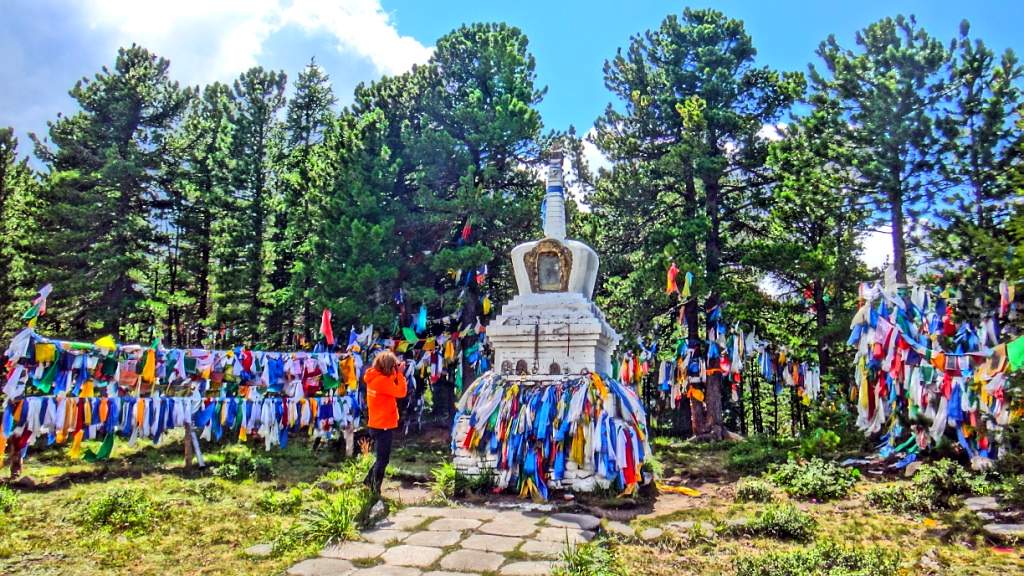
SACRED PLACES OF KHAKASIA
At the XII Congress of the Khakass people held on March 18, its participants approved a list of sacred places in Khakassia. The director of the Khakass Research Institute of Language, Literature and History, Doctor of Historical Sciences Valentina Tuguzhekova, told the Abakan correspondent why this list is needed and what objects were included in it.
The need to create a list of sacred places is caused by socio-economic changes recent years... Today we offer rent by private individuals vast territories(taiga, fields, etc.), on which objects sacred to the Khakass people can be located. And it is necessary to do everything possible so that these sacred places remain accessible for ritual practice. At the congress, we approved a list of 96 sacred places of the Khakass people, then we will transfer it to the Supreme Soviet of the republic. We hope that in the future, within the framework of the law on historical and cultural heritage, the sacred places of the Khakass people will be taken by the state under its protection.
What is considered a sacred place?
In Khakassia, a list of sacred places has been approved. The meaning of the word "sacred" (from the Latin "sacer" - sacred) is cult, ritual, secret. Sacred monuments of Khakassia are part of the Khakass ethnic culture.
Sacred, sacred place - a place with a sacred status; out-of-area feature Everyday life and designed to perform regular cult actions aimed at interacting with sacred entities and powers. It differs from mundane and religious spatial objects by the totality of ideal (spiritual) and material (physical) characteristics. Ideally, in the religious consciousness, a sacred place is a value of a high order, the earthly abode of spirits and gods, a concentration of magical powers that evokes a sense of reverence and requires an extraordinary respectful attitude. The presence of such characteristics in historical documents or ethnographic data makes it possible to identify a spatial object as a sanctuary, a sacred place.
A specific study of ancient sanctuaries shows that in most cases the places for their arrangement were not chosen arbitrarily. A person singled out places in the surrounding earthly world that cause strong emotional reactions, awaken the imagination and stimulate intellectual activity; these loci of space corresponded to religious ideas about the habitats of spirits, gods and other "forces" marked by the quality of holiness.
In the early stages of history, objects of the natural landscape (mountains, water sources, etc.) were marked strictly by genus. As a result, “ancestral territories” were formed, which had pronounced natural boundaries. During the development of the territory, the most important was landscape object(valley, mountain, lake, etc.), that is, the place where people gathered for social events. This is how the ancestral places of worship took shape.
Among the peoples of Southern Siberia natural places where national holidays, cult rites, and shaman rites were held, were considered sacred, that is, sacred places. As a rule, sacred sites are associated with the traditional worldview of the indigenous peoples of southern Siberia. As before, most of the indigenous peoples of Southern Siberia (Khakass, Tuvans, Altai, Shors) deify nature, natural elements, in folk memory and in ritual practice, worship of various natural elements, spirits: the spirit of fire, the spirit of water, the spirit of the mountains, etc. .d.
What was included in the list
In Khakassia, as in other regions of Southern Siberia, sacred places include not only sacred mountains, certain areas, but also archaeological sites: ancient burial mounds, stone statues, etc. According to ethnographer Viktor Butanaev's calculations, there are about 200 places of worship in Khakassia, according to the Council of Elders of the Republic of Khakassia, there are more than 300 of them.
The most revered sacred mountains among the Khakass population: Borus, Izykhskie, Uytag, Samokhval, Chests. The mountains formed the Khakass idea of their territory as a mountain-steppe country located in the center of the Sayano-Altai Highlands and surrounded on all sides by mountain ranges.
For example, Kuznetsky Alatau in the poetics of Khakass folklore is called "Ulgennig son" (Divine ridge), and Sayans - “Khan Tigir son” (Celestial ridge).
The great mountain peaks Khan-Purgus (Borus), Khan-Praday, Kol-Taiga, Khan-Chalban and others are ancestral mountains from which the Khakass seoks originate in life. To honor the mountain spirits, shamans performed rituals every three years.
The revered mountains and areas, which have their own patron spirits, were called "eelig chir" - literally "the land that has its owner." Usually there are anomalous phenomena associated with the tricks of mountain spirits. Khakass respect such places and, passing by, they must sprinkle with wine or tobacco.
On the mountain passes, sacred stone heaps - "oba", were poured in honor of the host spirits. Each passing person is obliged to bow to them and make their contribution here. As a rule, men threw stones taken during the ascent, and women stuck branches from birches from the east.
If a person passed through the pass for the first time, then he must have tied the sacred “turban” ribbon on the poles stuck in the “oba” piles, otherwise his life span would be shortened. You cannot laugh or sing songs around both. In the presence of wine, those present three times in the sun walked around the sacred heap of stones and sprinkled both with alcohol. It was forbidden to climb the passes at night.
In Khakassia, a list of sacred places has been approved.In addition to the sacred mountains, mountain passes, the Khakass have since ancient times revered the cult of water.
Every year, at the beginning of summer, on the new moon, they prayed for water (sug taiyi) at the sources of revered streams or on the banks of large rivers - Abakan, White and Black Iyusov, Chulym and Yenisei. V
In the lake edge of northern Khakassia, water sacrifice was carried out on the shores of the lakes. Prayers were held on such lakes as Haara-Kol (Black Lake), Os-Kol (Osinovoe), Ayran-Kol (Ayran Lake), Tigir-Kol (Heavenly Lake), etc.
In the valleys of the Abakan, Iyusov, Chulym and Yenisei rivers, the Khakass annually held Heavenly prayers. In Khakassia, more than a hundred mountains are noted, where prayers to the Great Sky were held on the dominant peaks, and 20 of them are called "Tigir taiychan tag" - the mountain of Heavenly sacrifice.
In some places, such as, for example, in the valleys of the Ulen, Kamyshta and Ninya rivers, every year heavenly prayers were held on different mountains, but after three years they returned to their original position. For example, the Kirbizhekovs' family spent the first year on Mount Bytag, then on the town of Khaibytag, in the third summer on the town of Khuyulyg-tag, then everything was repeated again. In the first year, the inhabitants of the aal Ust-Byur made a heavenly sacrifice on the city of Kolergit, in the second - on the city of Chan-sory, in the third - on the city of Izykh-tag in the upper reaches of the river. Uybat, and then again to Kolergit.
The Abakan Kachins (aal Troyakov and others) held a prayer to Heaven on Mount Saksor, on the right bank of the Uybat (a tributary of the Abakan). It was attended by residents of various seoks.
In addition to the veneration of the sacred mountains, water and sky, the Khakases from ancient times worshiped burial places (the cult of worship of ancestors), heavenly bodies, sacred menhirs, ancestral places, ancient sanctuaries. Of the most revered stone statues, Akh-tas (white stone) and Ulug Khurtuyakh-tas (Big stone old woman) should be noted. A kilometer to the north-east of the village of Kazanovka, on the left bank of the Askiz River, until the sixties of the twentieth century, the picturesque Iney-tas (Stone Old Woman) rock rose. This place has two more names: Hoarfrost-haya (Rock-old woman) and Hoarfrost-pair (foot of Hoarfrost). This monument had two meanings: it was the ancestral mountain of the Mainagashevs and the patron saint of cattle breeding for the entire local population.
This is not a complete list of sacred, sacred places in Khakassia, which have been revered and revered by modern Khakass since ancient times, where shamans traditionally conduct rituals of sacrifice and worship of spirits and ancestors. In total, as we have already noted, the congress approved 96 sacred places of the Khakass people.
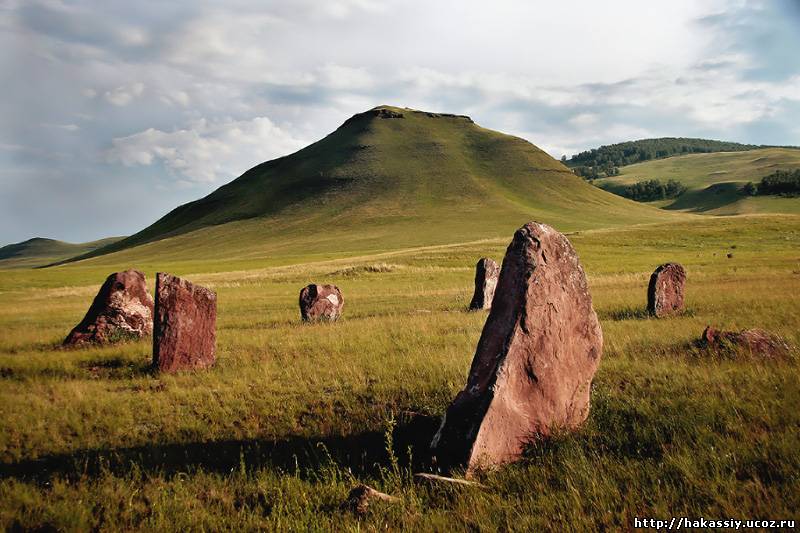
MENHIRS
The secret of the menhirs of Khakassia
The study of the locations of menhirs by the methods of geophysics and biolocation in Khakassia began at the end of the 20th century. The research was attended by Doctor of Historical Sciences, Professor Ya.I. Sunchugashev and I, a geophysical engineer. Such work was carried out during 1977 - 1999 under the program of the Khakass Research Institute of Language, Literature and History. In total, 25 sites of ancient statues were studied.
Menhirs are free-standing stone statues, near which sacrifices, cult rites and other mysterious ceremonial actions were performed five to four thousand years ago. Menhirs still contain many unsolved secrets, they are fraught with amazing discoveries.
Man has created the most complex technical systems, he can fly on spacecraft and study the depths of the oceans, “catch” fractions of a second and split atoms. Apparently, it is no coincidence that in ancient times man was called the microcosm - the earthly embodiment of the mind of the Universe.Many scientists have proved that our capabilities are far from being fully disclosed, they expand not only due to scientific and technological progress, but are also replenished with unconventional ways of knowing the world.
One of them is dowsing, or in the modern concept - dowsing. The human body is constantly experiencing the complex effects of various geophysical fields - electromagnetic, gravitational, radioactive, and so on. It was the active reaction of the frame in the hands of the biological locator near the menhirs that made us look for the reasons for this phenomenon. Dowsing anomalies near menhirs are quite impressive, and the effect observed here is very unexpected, yet unknown to science. This anomalous effect indicates that menhirs are located on the energy regions of the earth's surface.
Menhirs attracted and continue to attract the attention of storytellers, connoisseurs and performers of folklore. Storytellers in the course of the story of outstanding heroes the epic was skillfully introduced into poetic compositions and the power of the influence of menhirs on the world... So, in the legend "Ai Khuchin" it is said: "Having climbed a high stone ridge from the foot of the crooked menhir, he looked into the distance, but when he saw, he found that the copper menhir is the umbilical cord of the earth."
Apparently, the Khakass considered the places where menhirs were placed sacred and unusual. In the legend "Khan Kichigei" it is said that at the source of the light-stone river there is a white stone (ah tas), which must be lifted by the heroes passing here; many of them, unable to lift the white stone, died. circled this stone three times. The legend of three ceremonial circles around the white stone agrees with the reports of the first scientist-traveler who visited Khakassia and Siberia, DG Messershmidt. not far from these graves, I finally got to the statue widely known among these peoples ... Khurtuykh, located in the hilly steppe.
I immediately sketched it and later attached the drawing to these notes. Khurtuyakh is carved out of gray sandstone and dug into the ground obliquely. Behind, one could see thick braids, woven of hair, suspended in the form that Kalmyk and Tatar women wear them ... The pagan Tatars from Es Beltyr, who provided me with horses, showed great honor to this old woman; each of them circled around her three times ... put food in the grass closer to the pedestal so that she could use the food in accordance with her appetite. " Further, he notes that the statue is revered among the indigenous population, they bring it a river pebble as a gift, smear its mouth with oil, fat, milk and ask for health. Young women are being treated for infertility.
We are not alone in conducting such pagan rituals. So, in Belarus, the stone "Ded" (an exhibit of the museum of boulders in Minsk) once played a big role in the spiritual life of the people, because even a century and a half ago people came to him, looking for help in trouble. The stone "Ded" was given honey, milk, wine - poured onto the top of the boulder. When a woman was seriously ill, she put an apron on a boulder for 33 days. Another example is the famous boulders "Demyan" and "Marya", located on the outskirts of the village of Perezhir, Minsk region. It was believed that they have miraculous powers capable of healing paralytics, lame, deaf. The boulders were carried rich donations: flax, wool, bread, pigs, calves, sheep, money. It was believed that the result would be favorable if you make a pilgrimage to the stones at a certain time. Such a ritual, one to one, is similar to the ritual performed by the Khakass at the menhir Khurtuyakh.
The church was for the most part tolerant of the customs of the inhabitants. Moreover, crosses, chapels and temples were erected near the most famous boulders. People prayed, asked for the stone to get rid of misfortune and disease. They went to the stone both on the pagan holiday of Ivan Kupala, and on the Christian Trinity and Easter.
In the European part of Russia, experienced biological locators identified a number of energy areas, the so-called places of power: Solovki, Valaam, Kizhi, the pagan temple of Uksa on the right bank of Ladoga, Trinity-Sergius Lavra, where the cell of Sergius of Radonezh is located. So, the famous "place of power" Solovki - on the Bolshoy Zayatsky Island, where the famous "northern labyrinths", erected by an unknown people, are located. The people who entered these structures showed a kind of "alignment" of the functions of the body: for example, in 10 - 15 minutes, increased blood pressure returned to normal, and at the same time, a surge of vitality could occur.
Within Khakassia, we studied the sites of menhirs only in the territories of the Ust-Abakan, Askiz and Bogradsky districts. All studied menhirs are located in geopathogenic zones that are associated with fault zones crust... Geopathogenic zones are areas of the earth's surface emitting a stream of energy unknown to science. As a rule, the width of these zones is insignificant and varies from 10 to 50 meters, and the length is many hundreds of meters, and in some cases - kilometers. According to the shape and strength of the impact of these fields on the biological locator, we divided geopathogenic zones into two types: high-frequency (negative), when the vector of the measured field is directed "fan-shaped" (in these places there is an "imbalance" of the human biofield, which ultimately leads to pathology), and low-frequency (positive), where the sinusoidal shape of the curves of the dowsing effect is manifested, while the direction of the measured field vector in one part of the anomaly is fixed strictly vertically downward, in the other - upward. In these places, the human biofield is aligned, which contributes to its recovery.
For the sake of simplicity, let's call geopathogenic zones of the second type “places of power.” Three such places have been identified on the territory of Khakassia so far: the site of the stone statue Ulug Khurtuyakh tas, which is located on the 134th kilometer of the Abakan-Abaza highway in the Askiz district, where a museum Here it was determined by biolocation that the stone statue was established by ancient people within the low-frequency geopathogenic zone in its positive epicentral part. here it is about 450 conventional units.As already noted, Khurtuy was treated with various ailments, and was treated for infertility.And now this "place of power" is not empty, tens of thousands of people visit it every year.
The second is the parking place of two menhirs - Bolshoy Vorota, which are located in the Ust-Abakan region, two kilometers northeast of the Bolshoi Salbyk mound. Dowsing studies revealed that these monoliths were installed in a low-frequency geopathogenic zone, which was 23 meters wide. The dowsing anomaly in this place is sinusoidal with an intensity of 450 conventional units. The menhirs are set on the “bend” line of the curve. The stone on the right side (if you look at it from the south) has a depression in the shape of a human body. to perform some kind of ceremonial rites. On the end part of the monolith there is a tamga in the form of a contour of a human body with three rays emanating from the head. Everything indicates that this "place of power" was used by ancient people to eliminate certain ailments.
The third place is the territory of the Small Palace of the ancient Khakass state: on the 34th kilometer of the Abakan-Askiz highway, 50 meters east of the highway. Here, literally five meters from the southeastern corner of the "palace" excavation, a linear low-frequency geopathogenic zone with a width of 18 meters in the northeastern direction was revealed.The anomaly has a sinusoidal shape with an intensity of up to 800 conventional units. Apparently, this place was revered by ancient people, and earlier it was recorded by a menhir, but with the passage of time the stone was lost, most likely, “reused” in the construction of burial grounds, as was often the case in the Tagar and later eras. Many researchers believe that there was a hospital here. Whether it is true or not, but one thing is clear: the dowsing anomaly in this place is identical in form, structure and intensity with the anomalies found at the cult places of Ulug Khurtuy tas and the Big Gate, which were used for medicinal purposes. Therefore, today it became necessary to fix this anomalous zone by placing a corresponding stone statue here. This work was carried out by the republican council of elders of the Khakass people and its chairman Vladislav Torosov, who installed a granite menhir called Abchakh tas (stone grandfather).
For preventive and therapeutic purposes, I recommend that newspaper readers, if possible, visit "places of power" and stay there for at least 15 - 20 minutes. I advise you to bring containers with water with you and put them in the anomalous zone, because under the influence of the force field, the water molecules will be arranged in a certain order - that is, the water will become structured, the use of which will further contribute to the healing process.
The mention of the Koshkulak cave in an interview with the "white" shaman Tatyana Kobezhikova interested many readers living outside Khakassia, but having already heard about the mysterious underground. Their request is to tell you more about it. The freelance correspondent for "AiF on the Yenisei" Viktor Melnikov has long been collecting curious observations of visitors to the mysterious cave.
This place is known all over the world. It is officially included in the top five "scariest" places on the globe. Anomalous scientists call this mysterious void in the mountain range somewhat pompously: the cave of the black devil. Its geographical name does not sound so formidable - the Koshkulak cave. The name was given to her by one of the peaks of the spurs of the Kuznetsk Alatau - Koshkulak. From the village of Shira to it - a little more than 20 kilometers.
place of black rites 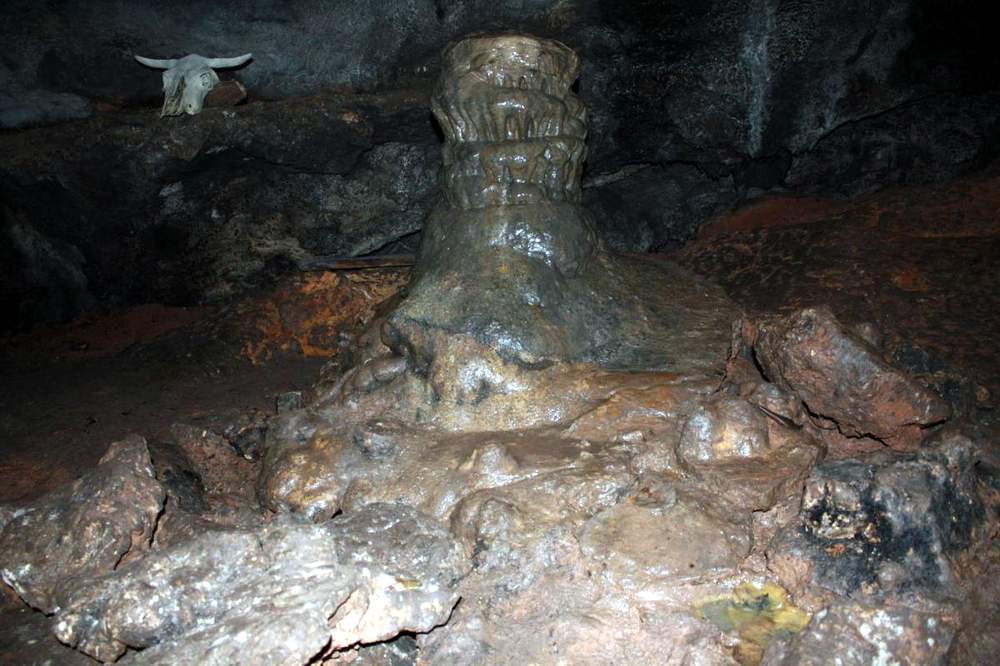
Young "old woman"
For the first time I heard about this cave about 15 years ago from my acquaintances speleologists, brothers Nikolay and Vladimir Savchenko. Returning from another trip to the caves of the Kuznetsk Alatau, they told me terrible stories about the half-rotted human bones found in the cave, about the shadows and sounds of the shaman's tambourine, about the causeless horror that they experienced when passing a certain section of this cave. The brothers also told the story, which they, in turn, heard on the campaign:
“In the 1960s, a group of 20 students climbed into this damn hole. Only two students came out of it. And then one girl in a violent deranged state was picked up by hunters near the cave. She bit and shouted something incoherent. The second student went “quietly.” At night she was found by a police squad from the village of Shira. Gray-haired, with a deathly face, with lips bitten in blood, she walked along the dark streets of the village. She did not want to give up for anything. Without stopping for a second, she whispered something very quickly and fervently. And this girl was assigned to the house of sorrow, where she "burned out" within a month from some mysterious disease.
Doctors were never able to establish the cause of death - the rapidly growing thin patient was, although insane, but absolutely healthy. Under the mattress of the young "old woman" who had exhaled her last breath, the nurse discovered a small stone figure ... "

Fox hat with horns
I confess - I did not believe the storytellers then. He even mocked them, accompanying their story with, as it seemed to me, witty comments: how much, they say, the brothers drank before listening to such tales. However, about half a year passed, and my acquaintances again set off on another trip to Koshkulak. In the group of 30 people there were mainly schoolchildren - it was the November holidays. Our tourists spent about three days near the cave. The first two underground expeditions went smoothly.
Having heard about the horrors of Koshkulak and dreamed of thrills, the schoolchildren were disappointed. On the third day, before leaving the camp, they asked the adults for the last time to "run through the cave." After they walked around all the grottoes, including the Skeleton Grotto, where usually, according to eyewitnesses, the incredible happens, the guys were already going to go upstairs.
At that moment, everyone suddenly felt a chilling attack of horror. Schoolchildren rushed to the exit, pushing aside equally frightened parents and teachers ...
Already in the light of the sun, when the fear let go, the pioneers and their guides vying with each other began to share what they fancied in the depths of the cave. Each, as it turned out, the horror had its own "guise". Some saw a terrible monster with the body of a bear and with a bloody human skull instead of a head, others saw huge crows sitting on a pile of bones, the third one "appeared" (including my familiar cavers) a disgusting old shaman in a filthy fox hat with horns, beating a tambourine and producing intricate body movements. With gestures he seemed to be calling to him ...
Some time after the group returned home, one of the participants in the campaign, a sixth grader, was found hanged in the attic of his own house. He left a suicide note with a very strange content. The boy wrote about some kind of stone devil, about dark holes and madness. And at the end: "... die, but remember the stones." The parents of the deceased boy claimed that this phrase was written in a different handwriting. 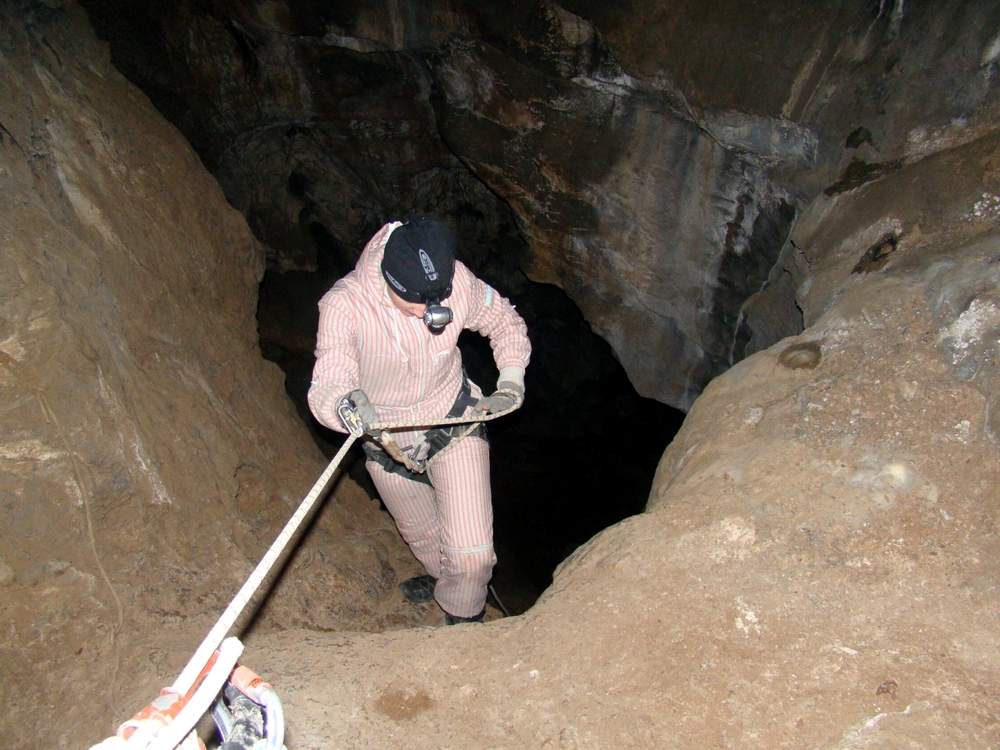
Scorching gaze
Back in the 1980s, scientists from the Novosibirsk Institute of Clinical and Experimental Medicine became interested in the rumors of ghosts that lived in its depths in the Koshkulak Cave. Expeditions were set up to study the phenomenon of the cave.
Perhaps, then, for the first time, scientists recognized that visions were not just the fantasies of sightseers who were afraid of the darkness. In 1985, an employee of the institute, Konstantin Vakulin, with a group of speleologists examined the grottoes. After several hours of work, people began to head for the exit. Konstantin was the last to go. I fastened the rope to a special belt and prepared for the climb. And suddenly he felt a gaze on himself. The scientist was bathed in heat. The first impulse is to run! But the legs did not obey. It was insanely scary to see what was happening behind my back. And yet, as if in a state of hypnosis, obeying someone else's will, he turned his head and saw about five meters away ... an elderly shaman.
The same, from the stories of my caver friends: fluttering clothes; a furry hat with horns, burning eyes and smooth, inviting movements with his hands - they say, go, follow me! .. Bakunin unconsciously took a few steps inward and immediately, as if throwing off a dark spell, began desperately pulling the rope. Not succumbing to the "persuasion" of the cave shaman, he, quite possibly, escaped the fate of those who were once perished or lost their minds.
Another member of the expedition, Nikolai Kamanov, witnessed almost the same visions.
Summarizing the evidence obtained, scientists suggested that all these hallucinations, unaccountable, panic fear, of course, not the intrigues of a dark force, but the result of a completely material external influence. It is known, for example, that infrasound with a frequency of about 6 hertz can cause a feeling of indescribable horror.
In one of the grottoes of the black devil's cave, a special laboratory was deployed. Researchers set up experiments there, carried out various measurements. As a result, a geomagnetic anomaly was established. The electromagnetic field in the cave is constantly fluctuating. Even at the initial stage of the study, scientists noticed that, among other signals, a strictly defined impulse is steadily breaking through. Sometimes he was recorded as a single person, it happened that he walked in "bundles". And always with the same amplitude. It happened that the signal disappeared for two or three days, or even for a week, but then invariably returned.
Sacred stalagmite 
Mysterious lighthouse
Scientists have asked themselves: where do these strange impulses come from? After a series of experiments, it was found that they make their way from the depths of the cave. It was decided to check if these impulses were connected with the eerie visions that are those who find themselves in the cave. The time of fixation of impulses exactly coincided with the moment of appearance in people of nervousness, a suppressed state, turning into panic horror.
The impulses, as the scientists assumed, turned out to be low-frequency. The very ones that are not perceived by the human ear, but have an impact on all living things, including the human psyche. But where are they coming from? The employees of the institute have no doubts that only an artificial emitter can generate such a frequency of pulses with a stable amplitude of oscillations. But where does it come from in the deep taiga, deep underground? Scientists examined the entire cave, descended into the most hidden corners - in vain. The search for an artificial emitter was unsuccessful. The mysterious lighthouse, if it only exists in nature, is even deeper.
As for hallucinations (and scientists consider creepy visions to be just harmless "glitches"), the study participants agreed on this version: the perception of non-existent objects as real can be caused by some unusual chemical mixture present in the air that fills the cave. However, what this mixture is and how much it has been studied is not yet known. The following question also remained open: why does the vision "come" to many in the guise of a shaman? It seems like it shouldn't be like that with hallucinations - this, like dreams, is an "exclusive" phenomenon. However, one-time expeditions could not, probably, dispel all the myths. The perestroika that began at that time posed much more burning questions. So, the solution to the secrets of the cave of the black devil is probably ahead. In the meantime, in the absence of a materialistic justification for what is happening in the underground, from mouth to mouth, along with heartbreaking stories, ancient legends are transmitted. 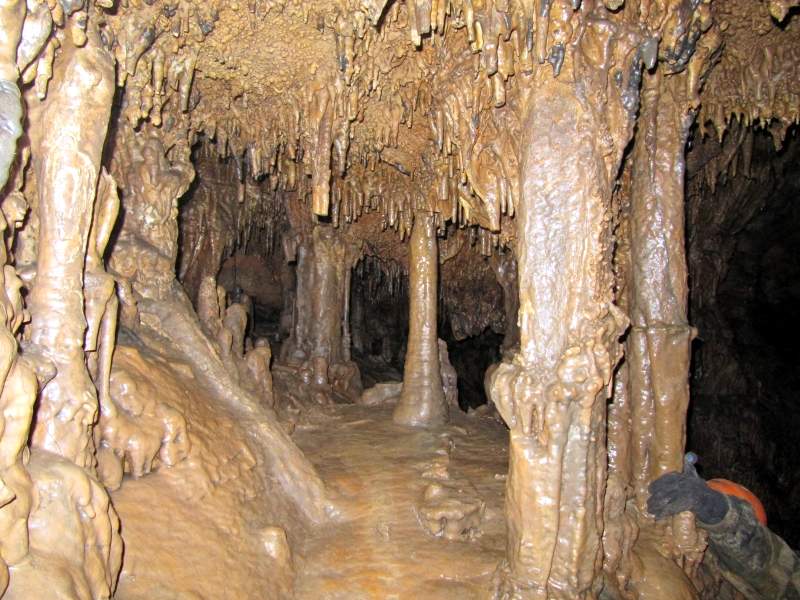
Shaman's Revenge
ONE of them in the previous issue of "AiF on the Yenisei" was shared by the "white" shaman Tatyana Kobezhikova. Once a shaman was buried not far from this cave. People disturbed his peace, and he punishes them with what appears to him in a dream, or even in reality in the form of a man in strange clothes, dragging him along. If you believe the local rumor, the spirit of the ancient Khakass shaman lives in the grotto of the Ghosts, which is next to the grotto of the Skeletons.
According to another legend, the Koshkulak cave was a cult place among the ancient Khakass. Here, the pagans worshiped not only the phallus as a symbol of procreation - an ancient fireplace was preserved around the natural stalagmite in the form of a phallus. Here, according to legend, the ancestors of the Khakass worshiped the black devil, made sacrifices to their gods, including human ones. An ancient altar that has survived to this day speaks in favor of this legend. Those who believe in this legend believe that over the centuries the cave has absorbed the dark energy of ancient shamans, which, guarding its secrets, spills out from time to time on overly curious guests of the cave.
grotto skeleton 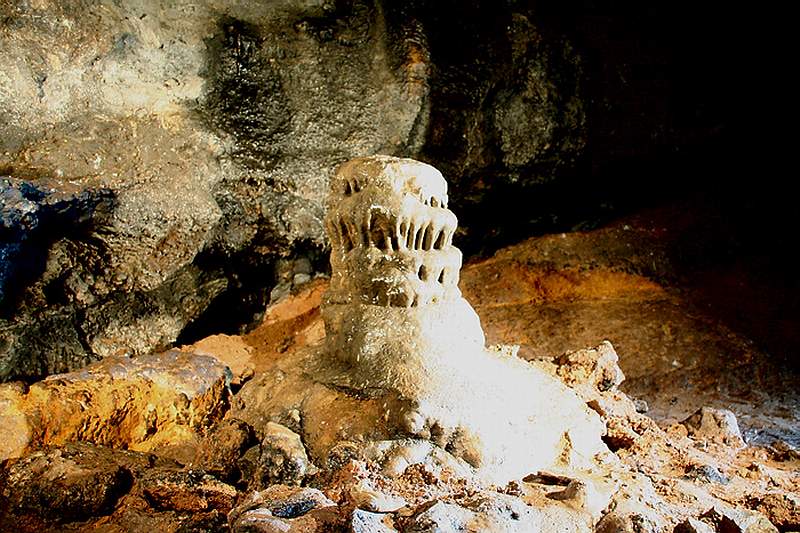
Kolchak's gold
The myths associated with the Koshkulak cave not only do not die, but are born. In booklets for tourists, for example, they will share with you the assumptions that Kolchak's gold is hidden in one of the grottoes of the cave of the black devil, that the secret warehouse of weapons of "Batka" Solovyov is lost here. The faithful Leninists cannot but be moved by such a version: the young commander of the Uzhur Chonites, Arkasha Golikov, just at the entrance to this cave received his legendary nickname Gaidar.
Road to hell
One of the most mysterious places in Khakassia is the Koshkulak cave. This mysterious place is located high in the mountains not far from the remote taiga village of Topanovo, Shirinsky region. It's dangerous to enter the cave without an experienced speleologist or a local guide - no joke - an almost vertical descent of about three hundred meters. And getting to the cave is not so easy - not every car can handle an inferior gravel road. Then walk uphill through the taiga on foot. And in the places of those animals of all kinds - in bulk. Whether you meet the soul of a shaman or not is still a question, but a brown bear is easy.
I tried to persuade some of the local residents to take them to this cave - it was useless. No money needed. They say that if the black shaman drags on, he will not let go.
Koshkulak is considered a cult place. Some say that once people were sacrificed in this cave (children were killed there or young women - no one can say for sure), and now this place has a very bad reputation. They say that the souls ruined cannot find peace and take revenge on the living for their joyless existence.
More than one scientific expedition visited there, some even saw this very black shaman, about whom the locals speak. One researcher who did not want to be identified told the following story:
“Our group went down to Koshkulak to check. The cave is not the deepest, in the Shirinsky region there is both deeper and more beautiful. And this, indeed, some kind of black, human bones, we, however, did not find there, but there are a lot of animal bones there. Maybe they come here to die. The sensations in this cave are not pleasant, but we did not notice any obvious manifestations of something special. Almost all of our group went upstairs. I was the last in the chain and for some time remained alone in the cave. Suddenly I felt someone's eyes on me. He turned around and was stunned: a creature separated from the wall - either a man or a beast - a body like a human, on his face something like a black mask, and on his head twisted horns. This creature looks at me and beckons with a finger. As if spellbound, I reached for the rope to untie the knot. At this time, someone from above called me, I woke up and pulled the rope with all my might. Was it a dream or a reality? But under the impression I walked for a long time. Sometimes I dreamed about this shaman (this is how the locals describe the black shaman). No, I will not climb into this cave again ”.
- 8,492 views
- Weapon sounds cs go for 1
- Festival "times and eras"
- Festival of avant-garde music Fields and "Masters of Music"
- Vdnkh: description, history, excursions, exact address Moscow Butterfly House
- After the overhaul, the Kurakina Dacha park was opened with the excavated Kozlov stream
- Library of Foreign Literature named after
- Governing Senate - Constitutional Court of the Russian Federation

 Live Journal
Live Journal Facebook
Facebook Twitter
Twitter